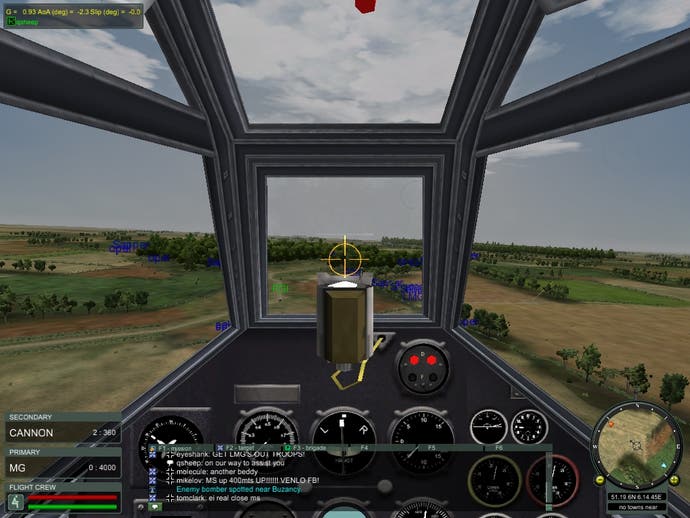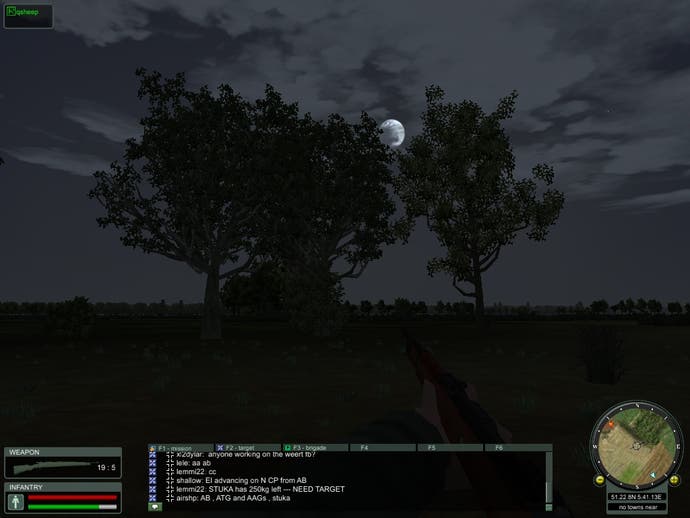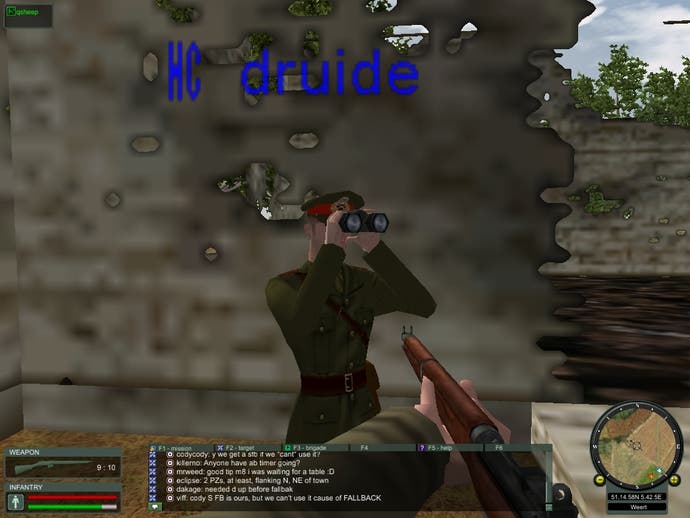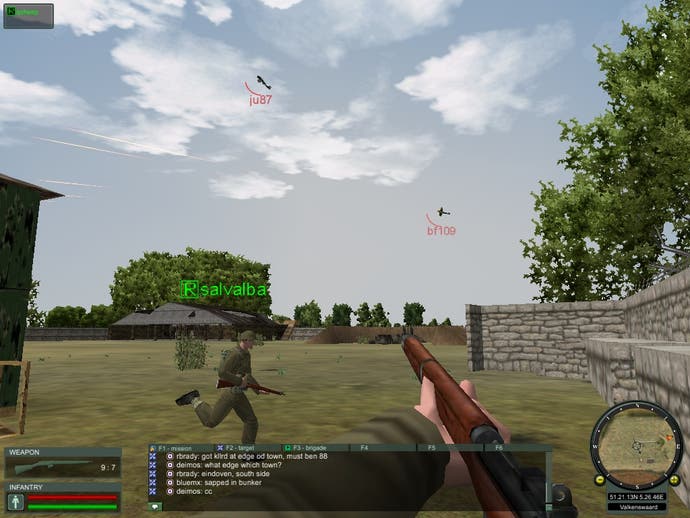Battleground Europe
"We shall fight in the fields and the streets..."
We’re big fans of World War 2 here at Eurogamer.
Oh, hang on, that just sounds wrong...
We’re big fans of World War 2 games here at Eurogamer.
The vision behind Battleground Europe - to us at least - seems like a unique and compelling one: fight it out online on the same World War 2 battlefield against thousands of people at the same time in a virtual land, sea and air war. You certainly can't argue with the scope and ambition.
Indeed, the playground provided is truly massive, with a game world that covers most of Europe; that's around 350,000 square miles of terrain in total. Add to that over 100 weapons and vehicles, with the promise of additional content all the time. Everything in the Battleground Europe World hinges on player interaction, with all decisions, from mission generation to re-supply being controlled by the player. Thus campaigns can take weeks or even months to complete depending on command staff decisions and tactics as well as ‘on the ground’ combat skills and numbers of players online at a particular time.
To kick off with, you can choose to play as one of three countries - Britain, France and Germany - serving in the infantry, air force or navy. As a new player, though, you’ll be limited to what units you can actually use.
Infantry infamy

If you plump for the infantry, you’ll start off as a rifleman, armed with just a rifle, knife, two grenades and a smoke grenade. Thanks to their unique ability of being able to physically capture installations, they're arguably the most important unit in the game, and one reason you’ll witness veteran players more than happy to get their hands dirty on the ground.
Should you fancy heading for the skies and joining the Air Force, you'll certainly get around quicker - but that’s if you can get off the ground in the first place. The sim-based handling model might simply put off the casual player completely. You have to work hard for your fun here, soldier. Each country offers players a different selection of flying machines, with slightly different handling for each. The German starter plane, for example, is the powerful but rather slow BF110 fighter, while the RAF gives players the more manoeuvrable but less lethal Hurricane. More planes become available as you gain rank, including the wonderful Spitfire, screaming Stuka, and even bombers such as the Heinkel III.
Navy wise, you’ll start off in a gunboat. Without a crew, these are pretty useless, but find some pals, and in the right place at the right time, they can be pretty damn handy. They’re also restricted to the waterways (obviously).
As you'd expect, moving up the ranks unlocks better equipment and unit types, and some high ranking players can create missions to defend installations, or towns, or to attack them. The target location appears on your radar with an orange triangle signalling the direction of your objective, and a blue one signalling your point of origin so you can return to base. Other than compass points, the radar itself gives you no other information at all. Not because it can’t, but because it doesn’t want to.
Reality bites

You see, because Battleground Europe is a simulator, it thrives on its realistic (i.e. extremely hard) approach to its subject mater. Sporting an almost vertical learning curve, you’ll spend the first couple of hours - at least - roaming around aimlessly, looking for something to shoot at. And most of the time, you won’t find it.
When we joined our first game, we thought we’d "do a Prince Harry" and put on a Nazi uniform. Picking a random infantry brigade to join, we chose to be a rifleman and entered our spawn point. A spawn point that was a deserted base, miles away from our target. Not the best start, it has to be said.
Controls follow the standard FPS layout, with the added ability to glance to your left and right using the Q and E keys as default. A handy feature for checking your peripheral vision. But don't assume or expect Battleground Europe to be a huge MMO version of Battlefield 1942 or Operation Flashpoint. For example, an infantryman can’t just get into any vehicle. Indeed, if you spawn in a vehicle, you can’t get out. If you start off in a tank, then you’re stuck with it until you’re dead, or until you return to base and de-spawn. This has the effect of disengaging you from the game as you can’t change units on the fly - you literally have to get out of the battlefield and re-spawn as something else.
Living is easy. Dying is easier

You’ll be re-spawning a lot, as dying is extremely easy. One or two hits as a soldier and you’ll go down, fast, with usually little idea of how you got killed or by whom, and worse still there are no medics in this game. Get hit, and you’re dead - sooner, rather than later we’d wager.
In another nod towards realism, enemy troops don’t have any indicators on them (oddly, yet thankfully, yours do), so you literally have to strain your eyes and ears (more on that later) to find the enemy - which isn’t easy at all. And it's even harder to spot your foe if you’re whizzing past a target area in a Hurricane, even at tree-top height.
In the name of excitement, we tried a few strafing runs against a town, firing randomly at the ground and buildings as we literally could not make out any enemy units, yet somehow we managed to destroy a tank - a tank we didn’t even know was there until later when it was listed as a kill on the report screen. This lack of feedback to the player removes to a degree any sense of accomplishment while ‘in game’.
Meanwhile, back on the ground, driving vehicles can be tough - you have to use gears to drive, for starters. If you’re alone in a tank you have to manually switch positions to fire the main gun, and this isn't exactly useful in the middle of a fight. You have the option to be part of a crew of course, but when we played we couldn’t find a tank needing one - or a plane for that matter.
As with most MMOs, Battleground Europe is daunting to get into. While a few kind fellows took it upon themselves to try and help us out, they were in the middle of a big battle happening miles away. Their help was friendly - and most definitely welcome - but it was a little sporadic. You'll find that you'll be fending for yourself for the most part using trial and error. The manual in the boxed version should help matters, but the game really should have more in-game assistance than it currently does.
My eyes! My beautiful eyes!

Graphically, the game looks awful. There, we’ve said it. Awful. It hurts our eyes to look at this game, it really does. And no, we’re not graphics whores, but really, releasing a game at the tail end of 2005 that doesn’t even match up to the original 1998 Half-Life in visual terms is not acceptable these days. Textures are flat and bland and structures angular and unrealistic, even on the highest performance settings. You can certainly see what things are supposed to be, but they just look very, very ugly and ruin the sense of realism and immersion.
Sounding off
Though graphically the game leaves a lot to be desired, in the audio department it excels. Every weapon and vehicle has a distinctive sound to it. You can hear the rumble of tank tracks long before you see the tank appear. The positional sound means that you can ascertain the general direction of enemy fire, or incoming aircraft quickly and easily. Additionally, many players seem to be able to recognise the sounds of different units, and often you’ll see reports in the chat tab warning of possible enemy units heard coming from a particular direction. This is especially useful at night when visibility drops to literally zero.
Battleground Europe has been around in one form or another for nearly as long as the real WWII lasted, so it’s admittedly a little unfair to judge it on just over a week’s play. Our advice? Well, if you like realism in your games and have enough time - and the patience of a saint to get over the steep learning curve - then give it a go. When it works, it works pretty well. We did have some fun with it, and can see its appeal and potential, but it makes you sweat for it.
The game seems torn between appealing to the hardcore - those that relish the realistic sim approach to the war - and encouraging new players to stick with it by making it more accessible. We can only hope that a balance is found so the game can expand its user base and truly fulfil its potential as it evolves further over time.
